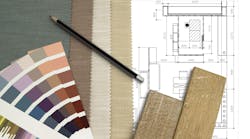By Susan Hayward and Jillian Hayward Schaible
Since the worlds of construction and design are so closely intertwined, the collaboration between those two disciplines is an artform that when mastered, can provide benefits to the involved teams and a given project’s end-user. Over the years, with multiple partnerships on different projects, we have perfected the balance between creativity and practicality, forging deep connections with contractors and subcontractors.
One of the essential strategies we have employed is approaching every project as a unified team, where each member's expertise is not only respected but celebrated. An open mindset and willingness to work together is the simplest but most effective practice from both the design and construction sides.
Begin with the Client
Every project’s journey begins with understanding the vision and goals of the client. When possible, we meticulously match contractors to clients, aligning not just with budgets, but with quality expectations and personalities. It's about finding the perfect fit, where trust and understanding thrive.
That level of synergy does not always come right away, however, and it takes time working together to truly understand how the styles and approaches of the clients and professionals may differ. In the early days of our interior design firm, we worked with a seasoned project manager who was skeptical of designers. We adapted and adjusted our approach, telling him he could consider us the “materials and finishes consultants,” and reassured him of his particular apprehensions that we would be on budget and on time. In response to that initial skepticism we practiced hyper-communication, and ultimately transformed the relationship into a decade-long partnership. Throughout this partnership, we all had opportunities to learn from each other: both in our work and in how we can always approach new partners with a different perspective.
Collaborate for Quality
In the creation of exceptional spaces, bespoke pieces often take center stage. Working with artisans is such a rewarding experience, not only because of the great pieces you’re able to create, but also because of what we are able to learn through the process.
For a recent commercial project, we needed a monumental table for a private dining room that would truly be a showpiece. We had a good idea of what was needed as far as size, shape, and color tone. Specifically, we wanted one slab, which immediately narrowed the field as to who could make it.
We could have easily sent off all our design specs to the artisan and waited for its completion. Instead, in collaboration with the artisan, we decided that this was going to be a design-as-you-go process. It was one of the easiest, most enjoyable experiences we ever had working on a custom piece of furniture with a woodworker, and they also said as much. We learned the ins-and-outs of creating this kind of bespoke piece and the complexities of woodworking, and really placed our trust in the artisan. His willingness to teach us was so beneficial to our growth as designers, and as such, we now have a great artisan that we are eager to sign on for another job.
Meticulous Planning
Our approach extends to all subcontractors—from tile installers to plumbers. We actively engage, recognizing their expertise and embracing their limitations. For us, it's not merely about delegating tasks; it's about hands-on involvement. We're on-site, meticulously sorting tiles, ensuring every hue aligns flawlessly. These extra steps, the attention to detail, communicate a profound message: we are in this together.
This proactive collaboration ensures precision and aligns every element with our client's vision. One significant advantage of this lies in the efficiency of decision-making. Unlike scenarios where clients grapple with indecision or product selection, we, as interior designers, ensure that every detail is meticulously planned. This precision means no delays, no setbacks—only a harmonious progression toward the project's completion.
Transformative Journeys
From the contractor’s perspective, understanding the multifaceted role of an interior designer is paramount. We urge contractors to respect the depth of our expertise, and we offer them the same. What worked in the past may not always be the best solution for the unique challenges posed by each project.
Embracing novel approaches not only enhances one’s skill set, but elevates their value in the industry. Working with interior designers opens doors to future contracts and projects of a larger scale. Clients who invest in interior design tend to have a comprehensive understanding of the construction process and appreciate the caliber of work that comes from a team of contractors and designers who have clearly communicated and worked well together.
In the realm of construction and design, our partnerships are not merely transactions; they're transformative journeys. By embracing the fusion of creativity and practicality new doors are opened for what is possible on a project. Rather than viewing these two facets as separate entities, conjoining their importance and how each decision from the construction side effects decisions for designs helps to view the project holistically.
Ultimately, we want the client to be happy and to create something beautiful. That we learn something along the way and build a great relationship with the other professionals on the job is just another reward that comes with the work we do.
Susan Hayward and Jillian Hayward Schaible are, respectively, Founder and Principal of Susan Hayward Interiors


